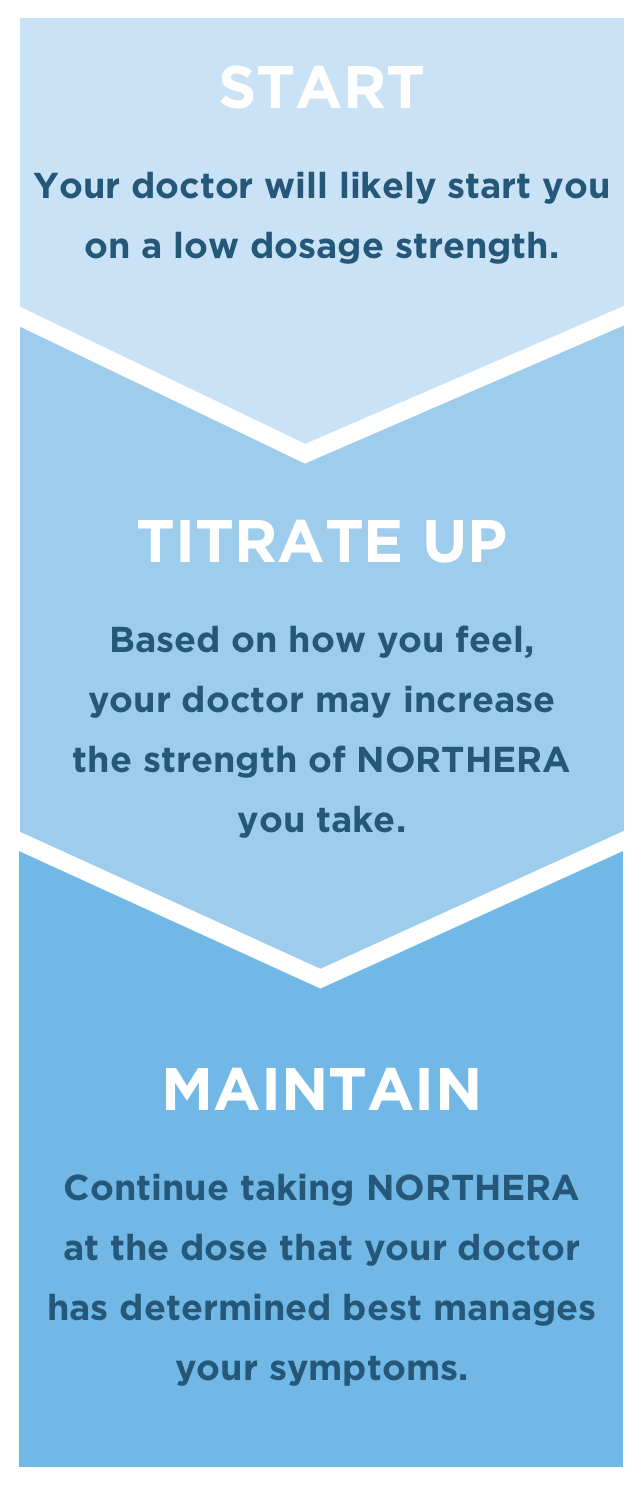Taking NORTHERA® (droxidopa)
What is titration?
When you start NORTHERA, your doctor will want to find the dose that works best for you. Your doctor will likely start you on NORTHERA at a low dose. Based on how well your symptoms are being managed, your doctor may increase the dose you take until you reach the dose that best manages your symptoms. This process is called titration.


It is recommended that the dose of NORTHERA be increased every 1 to 2 days. Your doctor will determine if and when your dose should be increased. In this video, you will learn about the titration process and how your doctor will adjust your NORTHERA dose to find what works best for you.
What Is Titration?
Text on the bottom of the screen throughout: Please listen to the Important Safety Information, including Boxed Warning for supine hypertension, in this video.
Text: Dr. Salima Brillman - Movement disorder specialist
Text on the bottom of the screen: NORTHERA® (droxidopa) is a prescription medication used to reduce dizziness, lightheadedness, or “the feeling that you are about to black out” in adults who have symptomatic neurogenic orthostatic hypotension (nOH) and who have Parkinson’s disease, multiple system atrophy, pure autonomic failure, dopamine beta-hydroxylase deficiency, or non-diabetic autonomic neuropathy.
Dr. Brillman writes on a notepad
Dr. Brillman: When I prescribe NORTHERA (droxidopa) for symptomatic neurogenic orthostatic hypotension finding the right dose is very personal. We take it person-by-person, step-by-step.
Text: Dr. David Shprecher - Movement disorder specialist
Text on the bottom of the screen: Do not take NORTHERA if you have a known allergy to NORTHERA or its ingredients.
Text on the bottom of the screen: Take your NORTHERA capsules whole. NORTHERA may be taken with or without food, but it should be taken the same way each time. NORTHERA is taken 3 times daily.
Dr. Shprecher talks to a patient
Dr. Shprecher: Doctors often use this term titration. Titration means a gradual increase in the dose of medication. So when I prescribe NORTHERA, I explain to patients that they need to take this medication 3 times a day. And we’re gradually going to increase the dose so we find a dose that helps with the symptoms, the dizziness and lightheadedness.
Dr. Brillman sits in a chair
Dr Shprecher: We're mainly just looking at the blood pressure readings, once a day, laying down and standing up to make sure the blood pressure doesn't get too high lying down and isn't getting too low standing up.
Dr Shprecher: We're also looking for an improvement in the symptoms that are impacting everyday life. So we'll have a plan to increase by a small amount and we'll agree upon increasing by that small amount until we get to the dose that best manages symptoms.
Text: NORTHERA may cause high blood pressure when lying down, which could lead to strokes, heart attacks, and death. To reduce this risk of supine hypertension, take your late afternoon dose of NORTHERA at least 3 hours before going to bed.
Use
NORTHERA (droxidopa) is a prescription medication used to reduce dizziness, lightheadedness, or the “feeling that you are about to black out” in adults who experience a significant drop in blood pressure when changing positions or standing (called symptomatic neurogenic orthostatic hypotension (nOH)) and who have one of the following:
- Parkinson’s disease (PD), a neurodegenerative disease that causes slowness in muscle movement as well as shaking in the hands
- Multiple system atrophy (MSA), a Parkinson’s-like disorder with more widespread effects on the brain and body
- Pure autonomic failure (PAF), a neurodegenerative disease that results in frequent drops in blood pressure upon standing
- Dopamine beta-hydroxylase deficiency, a condition where the body cannot make enough of the hormones that help regulate blood pressure
- Non-diabetic autonomic neuropathy, an inability to maintain blood pressure upon standing that can be caused by a number of rare diseases
Effectiveness beyond 2 weeks of treatment has not been established, and your doctor will decide if you should continue taking NORTHERA.
IMPORTANT SAFETY INFORMATION
WARNING: SUPINE HYPERTENSION (this is high blood pressure while lying down)
When lying down, elevating the head and upper body lowers the risk of high blood pressure. Check your blood pressure in this position prior to starting and during NORTHERA treatment. If you experience high blood pressure, talk to your doctor about your NORTHERA treatment.
- Do not take NORTHERA if you have a known allergy to NORTHERA or its ingredients.
- NORTHERA may cause high blood pressure when lying down, which could lead to strokes, heart attacks, and death. To reduce this risk of supine hypertension, take your late afternoon dose of NORTHERA at least 3 hours before going to bed.
- Neuroleptic malignant syndrome (NMS) is a rare but potentially life-threatening side effect reported with NORTHERA. Call your doctor right away and go to the nearest emergency room if you develop these signs and symptoms: high fever, stiff muscles, movements that you cannot control, confusion or problems thinking, very fast or uneven heartbeats, or increased sweating. NORTHERA should be stopped immediately if NMS is diagnosed.
- If you have coronary artery disease, irregular heartbeat, or heart failure, NORTHERA may worsen the symptoms of these disorders. Call your doctor if your symptoms become worse.
- NORTHERA may cause allergic reactions. Stop taking NORTHERA and contact your doctor right away, or go to the nearest emergency room if you experience any signs or symptoms of an allergic reaction such as: fast heartbeat, nausea, vomiting, swelling, trouble breathing, hives, or rash. NORTHERA contains tartrazine (FD&C Yellow No. 5), which may also cause an allergic reaction, especially if you have had a reaction to aspirin.
- The most common side effects with NORTHERA are headache, dizziness, nausea, and high blood pressure.
- Taking NORTHERA with other medications may cause side effects. Tell your doctor if you take prescription or over-the-counter medicines, vitamins, or herbal supplements.
- You should not breastfeed during treatment with NORTHERA.
- If you plan to become or are currently pregnant, talk to your doctor as it is not known if NORTHERA could harm your unborn baby.
- Take NORTHERA the same way each time, either with or without food.
- If you miss a dose of NORTHERA, take your next dose at the regularly scheduled time. Do not double the dose.
For more information, please see the full Prescribing Information, including Boxed Warning for supine hypertension.
You are encouraged to report negative side effects of prescription drugs to the FDA. Visit www.fda.gov/medwatch, or call 1-800-FDA-10881-800-FDA-1088.
“When I first started NORTHERA, I was seeing my doctor every day or every couple of days to titrate my [dose] until we got it just right.”
—GAIL, LIVES WITH PARKINSON'S DISEASE AND SYMPTOMATIC nOH
NORTHERA is available in 100 mg, 200 mg, and 300 mg capsules

FOR ORAL ADMINISTRATION. NOT ACTUAL SIZES.
Once you and your doctor find the dose that relieves your symptoms, your doctor may prescribe capsules at a higher dosage strength for your maintenance dose. This is intended to help reduce the number of capsules taken daily. Ask your doctor about your options.
NORTHERA safety and side effects
As with any prescription medication, there are potential side effects and safety considerations you should be aware of before starting NORTHERA.
- Do not take NORTHERA if you have a known allergy to NORTHERA or its ingredients.
- NORTHERA may cause high blood pressure when lying down, which could lead to strokes, heart attacks, and death. To reduce this risk of supine hypertension, take your late afternoon dose of NORTHERA at least 3 hours before going to bed.
- Neuroleptic malignant syndrome (NMS) is a rare but potentially life-threatening side effect reported with NORTHERA. Call your doctor right away and go to the nearest emergency room if you develop these signs and symptoms: high fever, stiff muscles, movements that you cannot control, confusion or problems thinking, very fast or uneven heartbeats, or increased sweating. NORTHERA should be stopped immediately if NMS is diagnosed.
- If you have coronary artery disease, irregular heartbeat, or heart failure, NORTHERA may worsen the symptoms of these disorders. Call your doctor if your symptoms become worse.
- NORTHERA may cause allergic reactions. Stop taking NORTHERA and contact your doctor right away, or go to the nearest emergency room if you experience any signs or symptoms of an allergic reaction such as: fast heartbeat, nausea, vomiting, swelling, trouble breathing, hives, or rash. NORTHERA contains tartrazine (FD&C Yellow No. 5), which may also cause an allergic reaction, especially if you have had a reaction to aspirin.
- The most common side effects with NORTHERA are headache, dizziness, nausea, and high blood pressure.
- Taking NORTHERA with other medications may cause side effects. Tell your doctor if you take prescription or over-the-counter medicines, vitamins, or herbal supplements.
- You should not breastfeed during treatment with NORTHERA.
- If you plan to become or are currently pregnant, talk to your doctor as it is not known if NORTHERA could harm your unborn baby.
- Take NORTHERA the same way each time, either with or without food.
- If you miss a dose of NORTHERA, take your next dose at the regularly scheduled time. Do not double the dose.
Please see Important Safety Information, including Boxed Warning for supine hypertension.
For more information, see the full Prescribing Information.
Use
NORTHERA (droxidopa) is a prescription medication used to reduce dizziness, lightheadedness, or the “feeling that you are about to black out” in adults who experience a significant drop in blood pressure when changing positions or standing (called symptomatic neurogenic orthostatic hypotension (nOH)) and who have one of the following:
- Parkinson’s disease (PD), a neurodegenerative disease that causes slowness in muscle movement as well as shaking in the hands
- Multiple system atrophy (MSA), a Parkinson’s-like disorder with more widespread effects on the brain and body
- Pure autonomic failure (PAF), a neurodegenerative disease that results in frequent drops in blood pressure upon standing
- Dopamine beta-hydroxylase deficiency, a condition where the body cannot make enough of the hormones that help regulate blood pressure
- Non-diabetic autonomic neuropathy, an inability to maintain blood pressure upon standing that can be caused by a number of rare diseases
Effectiveness beyond 2 weeks of treatment has not been established, and your doctor will decide if you should continue taking NORTHERA.
IMPORTANT SAFETY INFORMATION
WARNING: SUPINE HYPERTENSION (this is high blood pressure while lying down)
When lying down, elevating the head and upper body lowers the risk of high blood pressure. Check your blood pressure in this position prior to starting and during NORTHERA treatment. If you experience high blood pressure, talk to your doctor about your NORTHERA treatment.
- Do not take NORTHERA if you have a known allergy to NORTHERA or its ingredients.
- NORTHERA may cause high blood pressure when lying down, which could lead to strokes, heart attacks, and death. To reduce this risk of supine hypertension, take your late afternoon dose of NORTHERA at least 3 hours before going to bed.
- Neuroleptic malignant syndrome (NMS) is a rare but potentially life-threatening side effect reported with NORTHERA. Call your doctor right away and go to the nearest emergency room if you develop these signs and symptoms: high fever, stiff muscles, movements that you cannot control, confusion or problems thinking, very fast or uneven heartbeats, or increased sweating. NORTHERA should be stopped immediately if NMS is diagnosed.
- If you have coronary artery disease, irregular heartbeat, or heart failure, NORTHERA may worsen the symptoms of these disorders. Call your doctor if your symptoms become worse.
- NORTHERA may cause allergic reactions. Stop taking NORTHERA and contact your doctor right away, or go to the nearest emergency room if you experience any signs or symptoms of an allergic reaction such as: fast heartbeat, nausea, vomiting, swelling, trouble breathing, hives, or rash. NORTHERA contains tartrazine (FD&C Yellow No. 5), which may also cause an allergic reaction, especially if you have had a reaction to aspirin.
- The most common side effects with NORTHERA are headache, dizziness, nausea, and high blood pressure.
- Taking NORTHERA with other medications may cause side effects. Tell your doctor if you take prescription or over-the-counter medicines, vitamins, or herbal supplements.
- You should not breastfeed during treatment with NORTHERA.
- If you plan to become or are currently pregnant, talk to your doctor as it is not known if NORTHERA could harm your unborn baby.
- Take NORTHERA the same way each time, either with or without food.
- If you miss a dose of NORTHERA, take your next dose at the regularly scheduled time. Do not double the dose.
For more information, please see the full Prescribing Information, including Boxed Warning for supine hypertension.
You are encouraged to report negative side effects of prescription drugs to the FDA. Visit www.fda.gov/medwatch, or call 1-800-FDA-10881-800-FDA-1088.
Please see Important Safety Information, including Boxed Warning for supine hypertension.
For more information, see the full Prescribing Information.
Use
NORTHERA (droxidopa) is a prescription medication used to reduce dizziness, lightheadedness, or the “feeling that you are about to black out” in adults who experience a significant drop in blood pressure when changing positions or standing (called symptomatic neurogenic orthostatic hypotension (nOH)) and who have one of the following:
- Parkinson’s disease (PD), a neurodegenerative disease that causes slowness in muscle movement as well as shaking in the hands
- Multiple system atrophy (MSA), a Parkinson’s-like disorder with more widespread effects on the brain and body
- Pure autonomic failure (PAF), a neurodegenerative disease that results in frequent drops in blood pressure upon standing
- Dopamine beta-hydroxylase deficiency, a condition where the body cannot make enough of the hormones that help regulate blood pressure
- Non-diabetic autonomic neuropathy, an inability to maintain blood pressure upon standing that can be caused by a number of rare diseases
Effectiveness beyond 2 weeks of treatment has not been established, and your doctor will decide if you should continue taking NORTHERA.
IMPORTANT SAFETY INFORMATION
WARNING: SUPINE HYPERTENSION (this is high blood pressure while lying down)
When lying down, elevating the head and upper body lowers the risk of high blood pressure. Check your blood pressure in this position prior to starting and during NORTHERA treatment. If you experience high blood pressure, talk to your doctor about your NORTHERA treatment.
- Do not take NORTHERA if you have a known allergy to NORTHERA or its ingredients.
- NORTHERA may cause high blood pressure when lying down, which could lead to strokes, heart attacks, and death. To reduce this risk of supine hypertension, take your late afternoon dose of NORTHERA at least 3 hours before going to bed.
- Neuroleptic malignant syndrome (NMS) is a rare but potentially life-threatening side effect reported with NORTHERA. Call your doctor right away and go to the nearest emergency room if you develop these signs and symptoms: high fever, stiff muscles, movements that you cannot control, confusion or problems thinking, very fast or uneven heartbeats, or increased sweating. NORTHERA should be stopped immediately if NMS is diagnosed.
- If you have coronary artery disease, irregular heartbeat, or heart failure, NORTHERA may worsen the symptoms of these disorders. Call your doctor if your symptoms become worse.
- NORTHERA may cause allergic reactions. Stop taking NORTHERA and contact your doctor right away, or go to the nearest emergency room if you experience any signs or symptoms of an allergic reaction such as: fast heartbeat, nausea, vomiting, swelling, trouble breathing, hives, or rash. NORTHERA contains tartrazine (FD&C Yellow No. 5), which may also cause an allergic reaction, especially if you have had a reaction to aspirin.
- The most common side effects with NORTHERA are headache, dizziness, nausea, and high blood pressure.
- Taking NORTHERA with other medications may cause side effects. Tell your doctor if you take prescription or over-the-counter medicines, vitamins, or herbal supplements.
- You should not breastfeed during treatment with NORTHERA.
- If you plan to become or are currently pregnant, talk to your doctor as it is not known if NORTHERA could harm your unborn baby.
- Take NORTHERA the same way each time, either with or without food.
- If you miss a dose of NORTHERA, take your next dose at the regularly scheduled time. Do not double the dose.
For more information, please see the full Prescribing Information, including Boxed Warning for supine hypertension.
You are encouraged to report negative side effects of prescription drugs to the FDA. Visit www.fda.gov/medwatch, or call 1-800-FDA-10881-800-FDA-1088.




